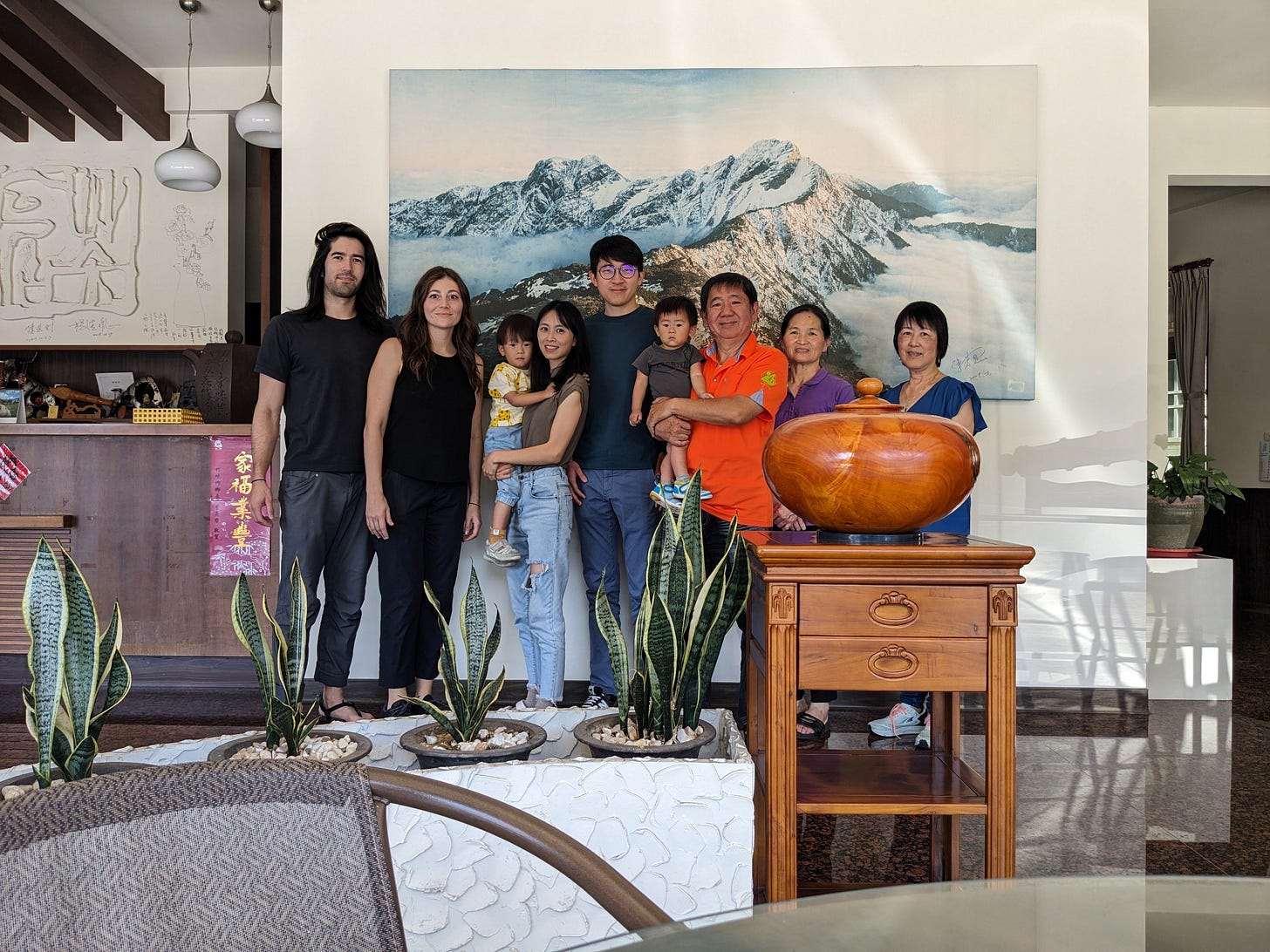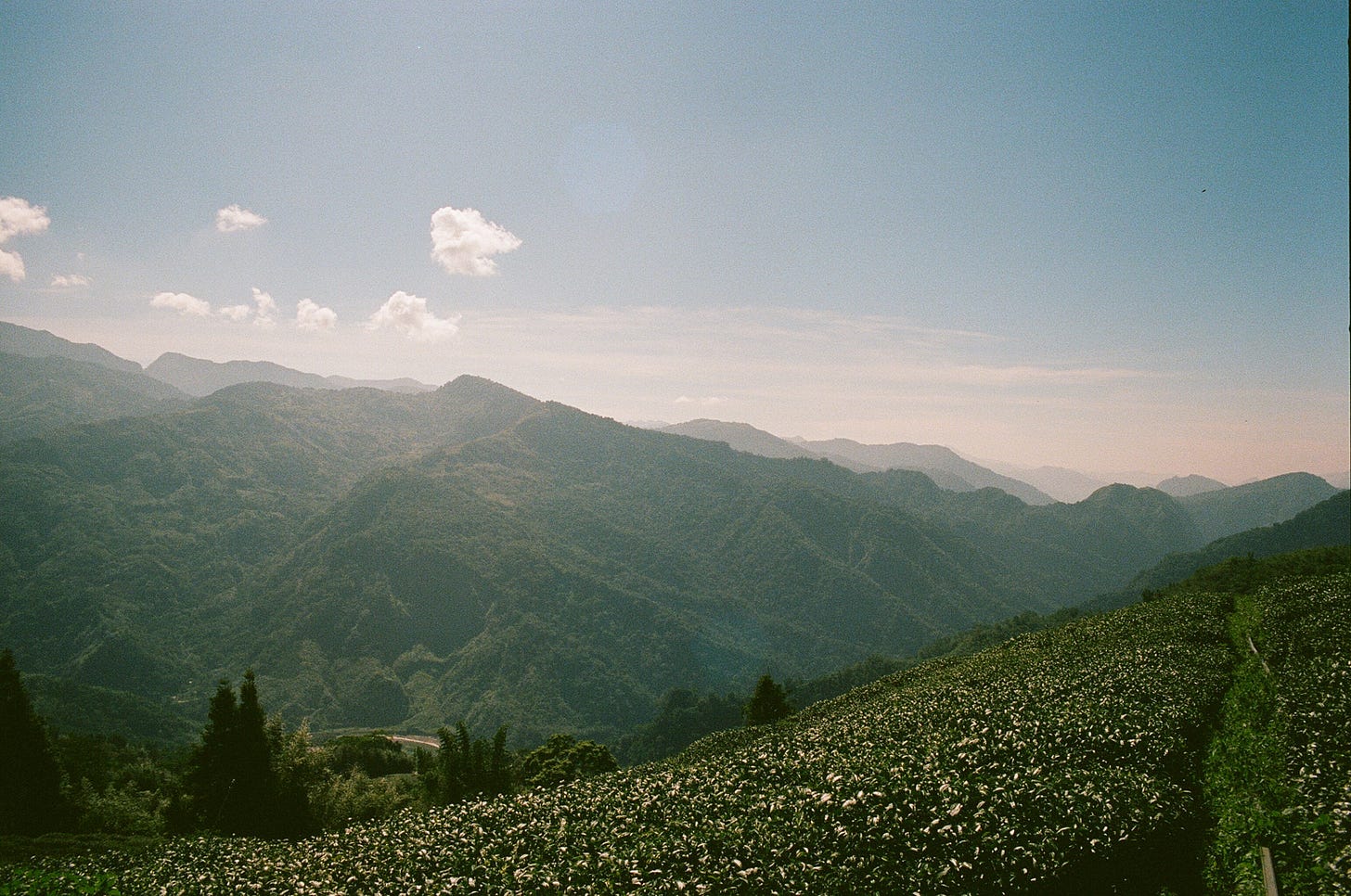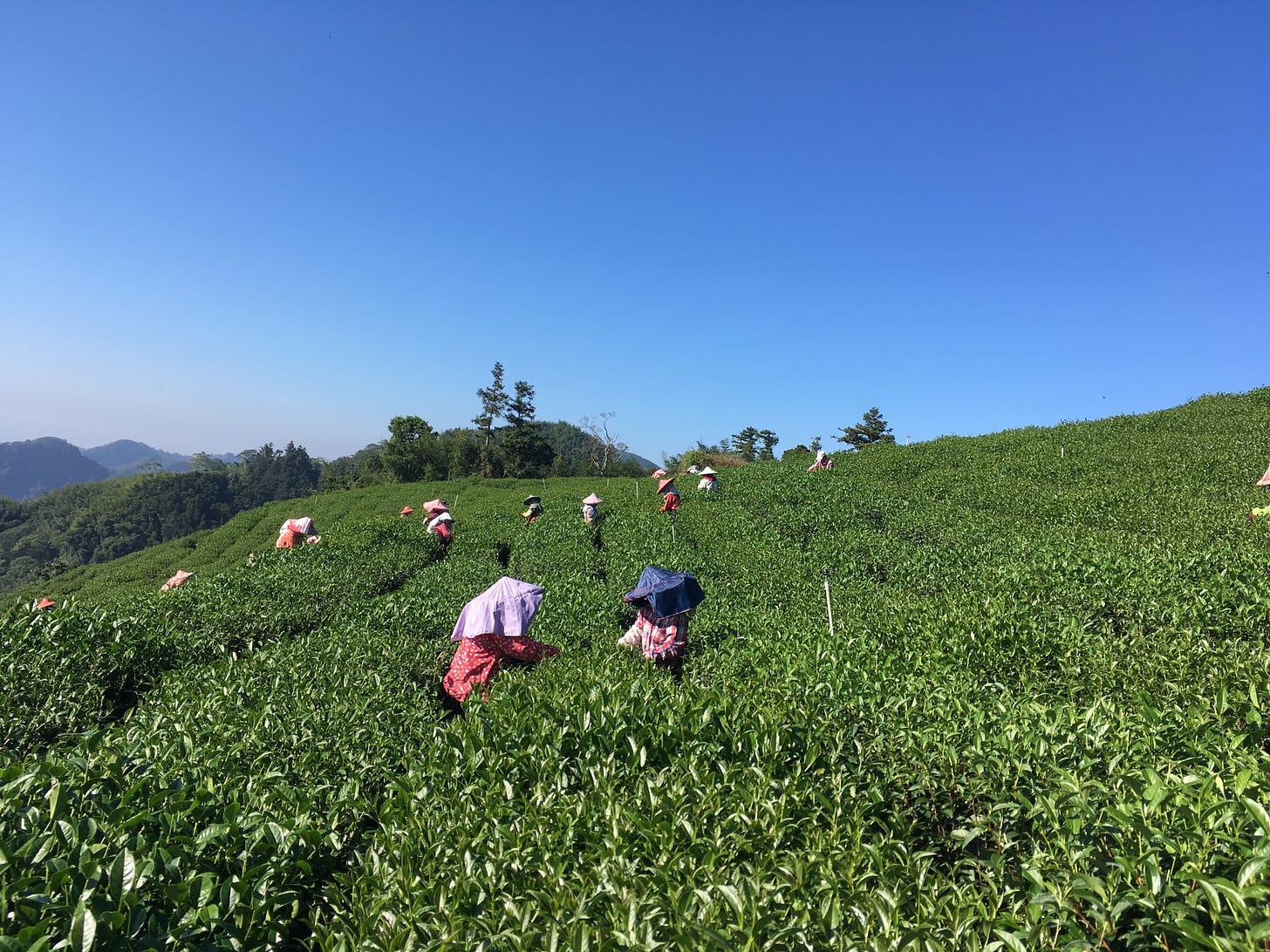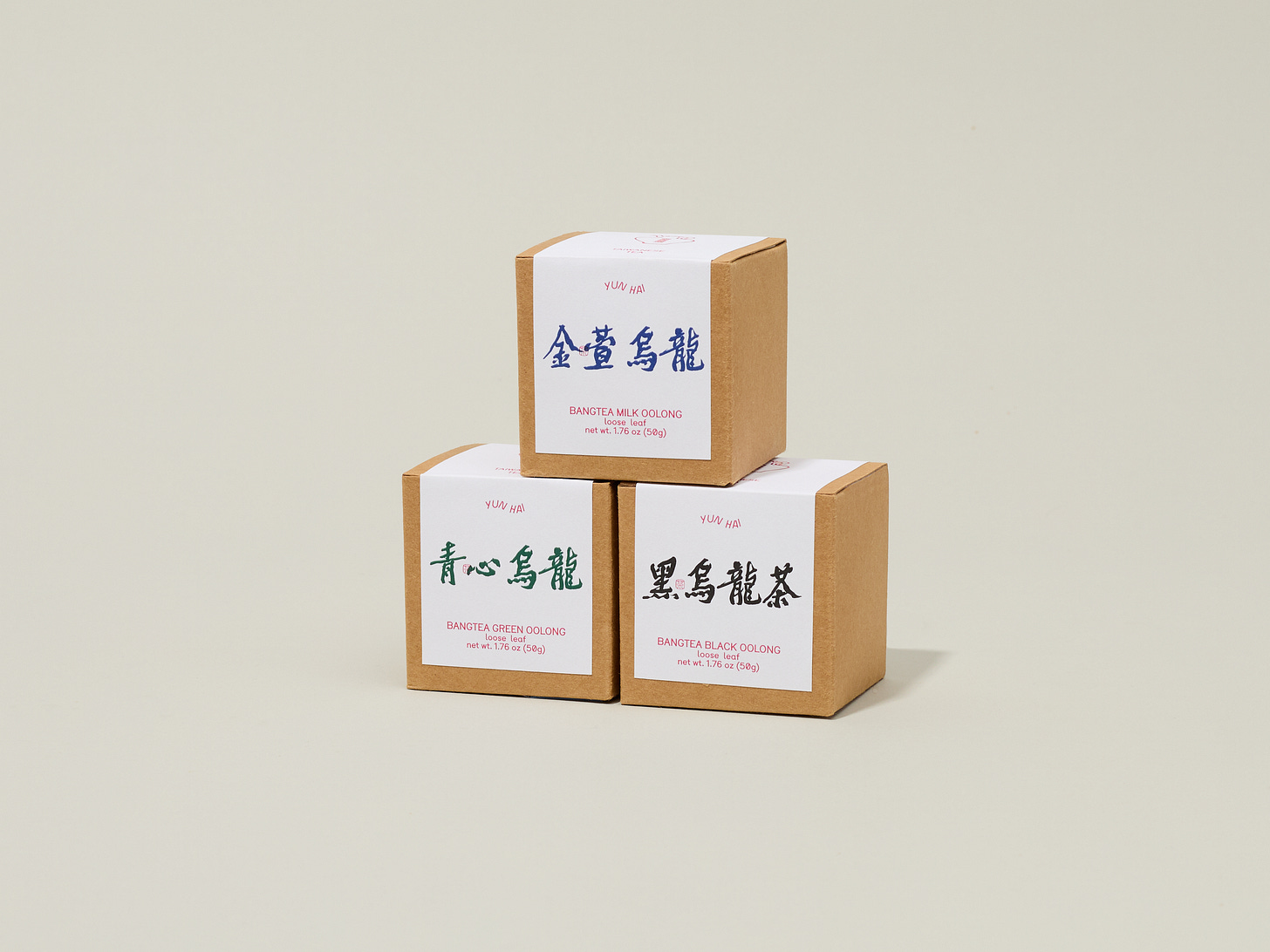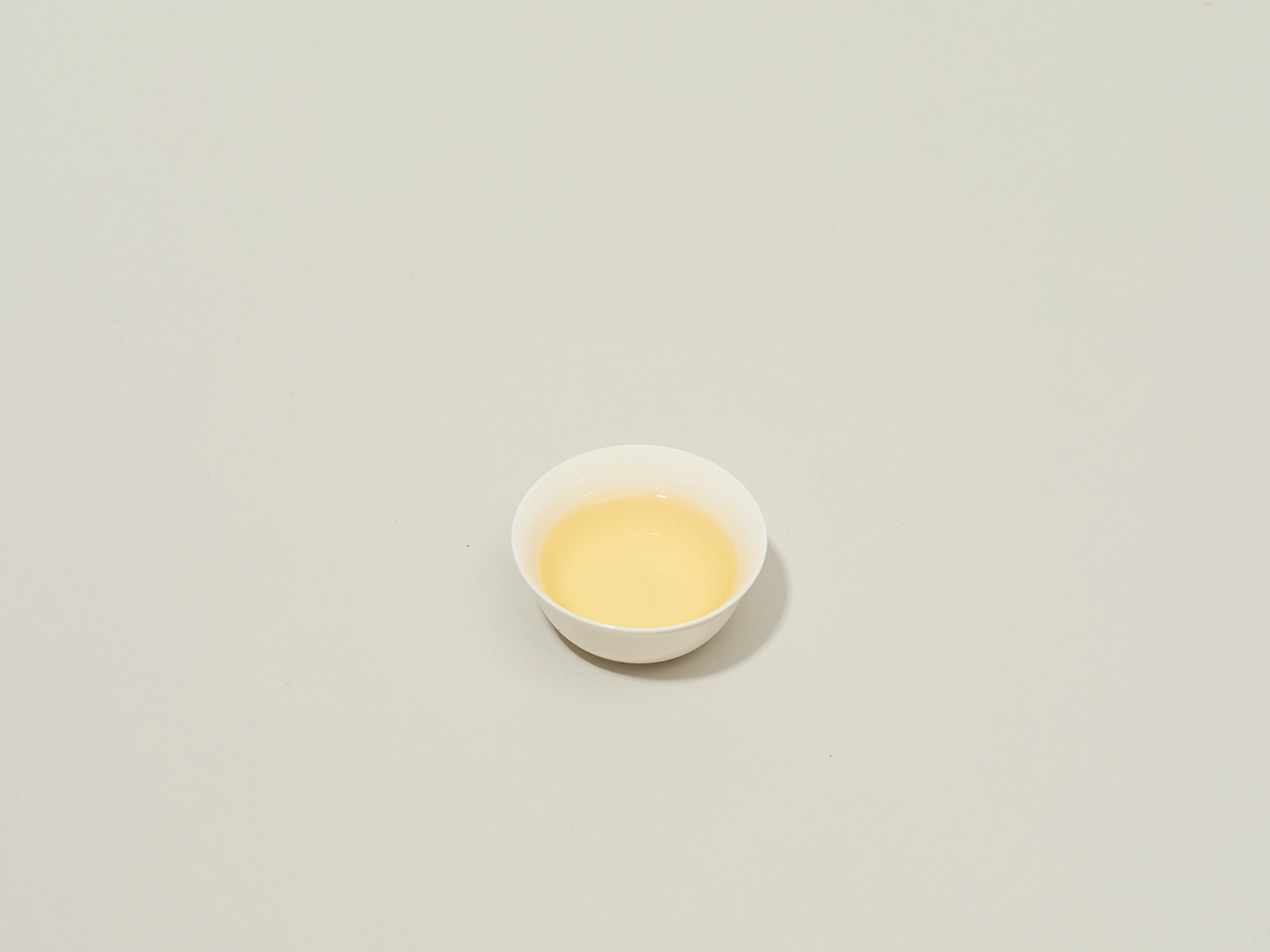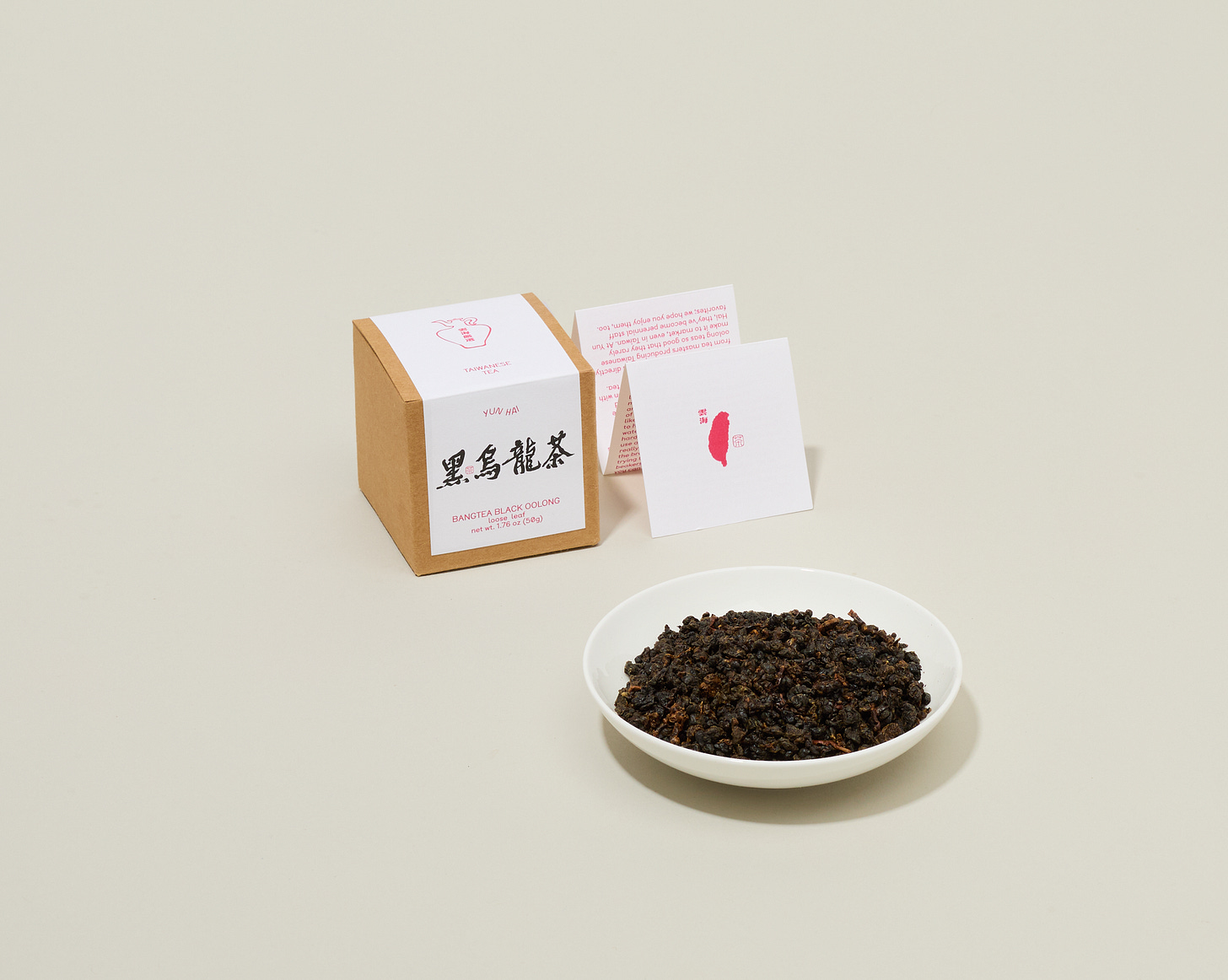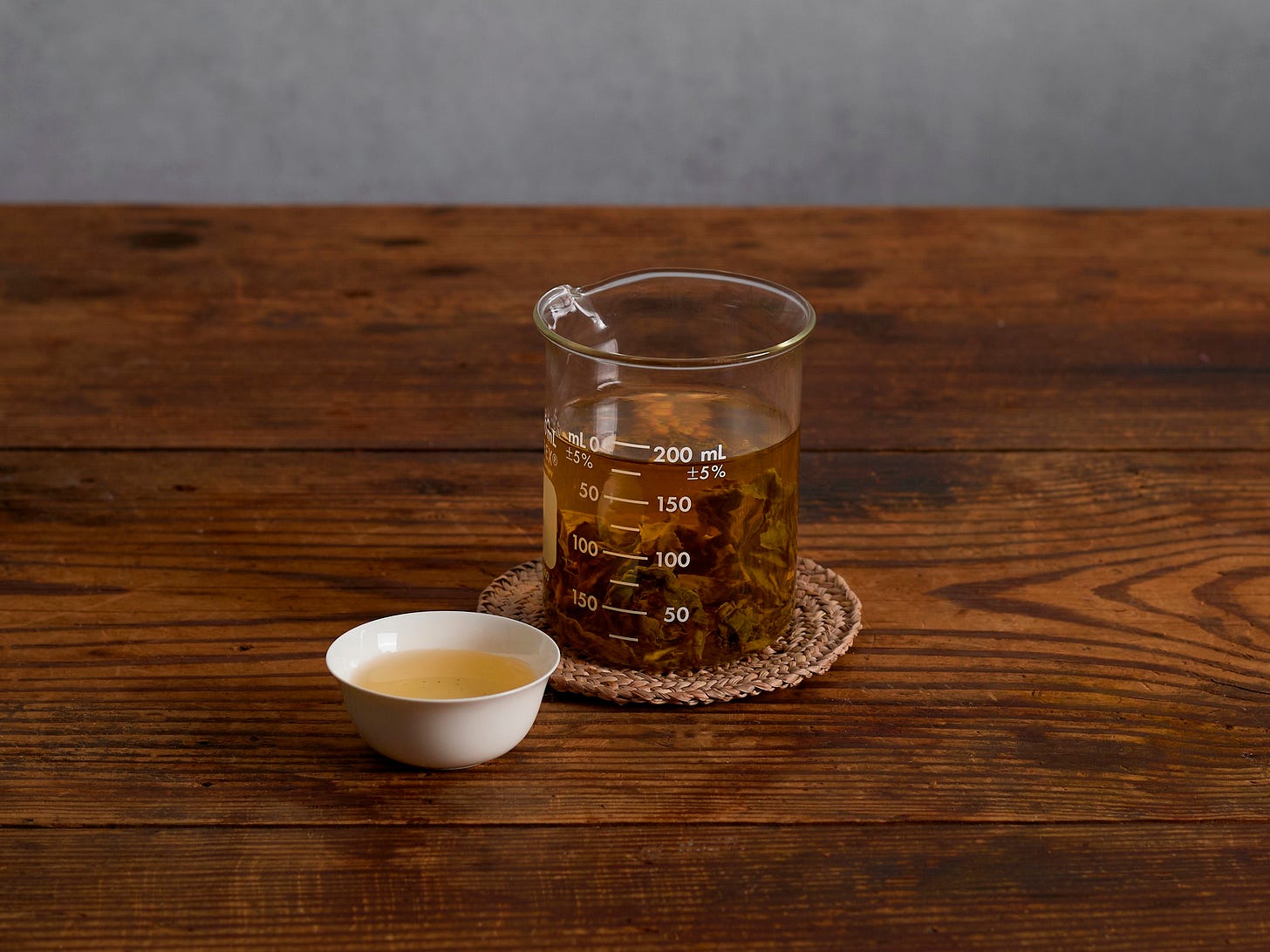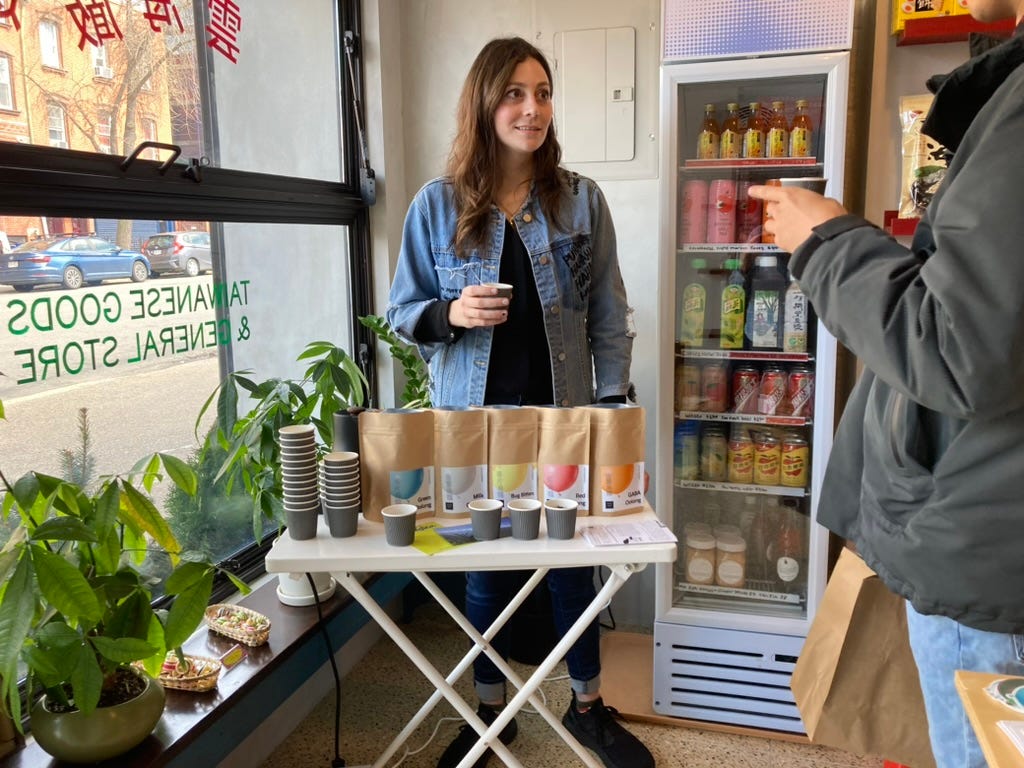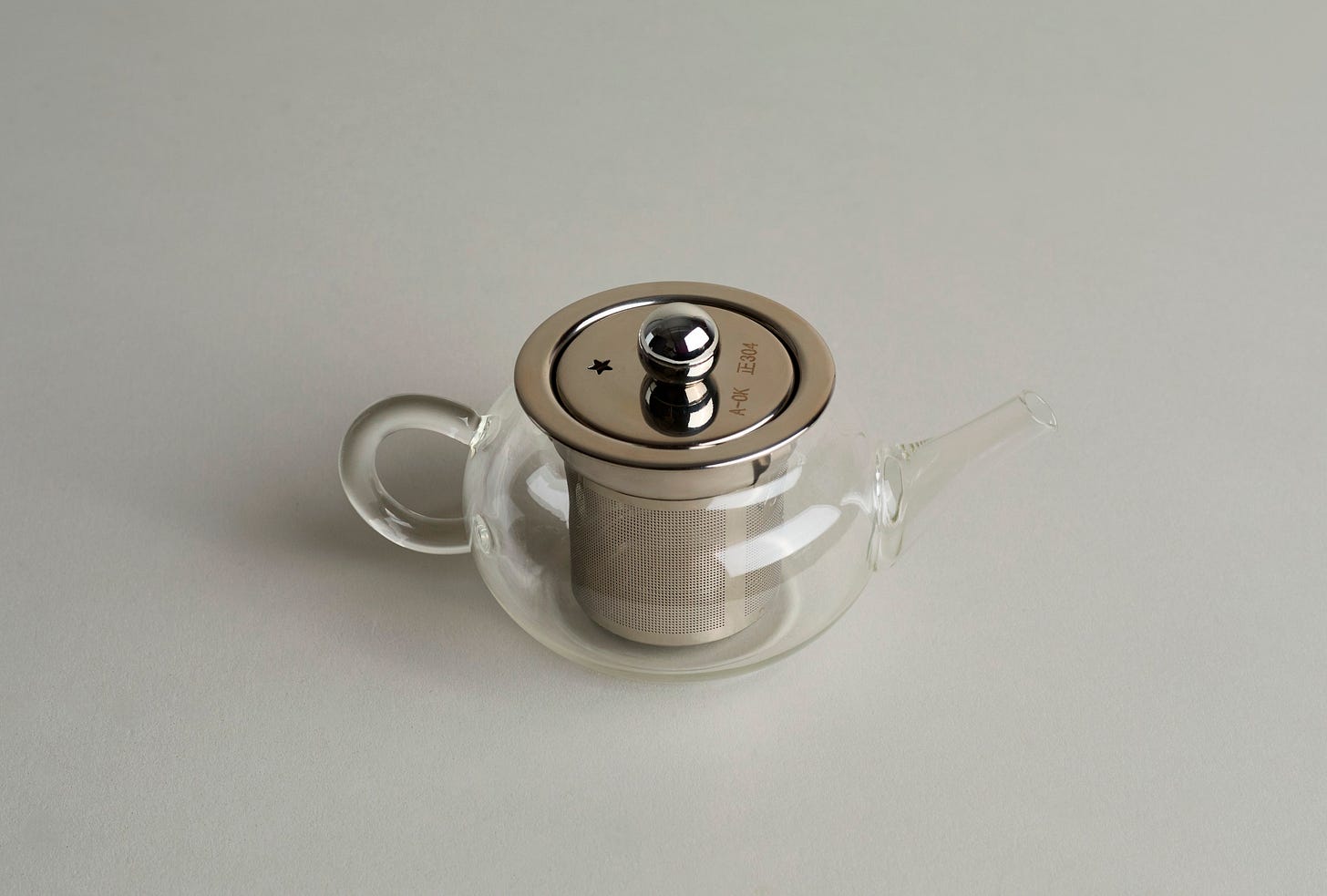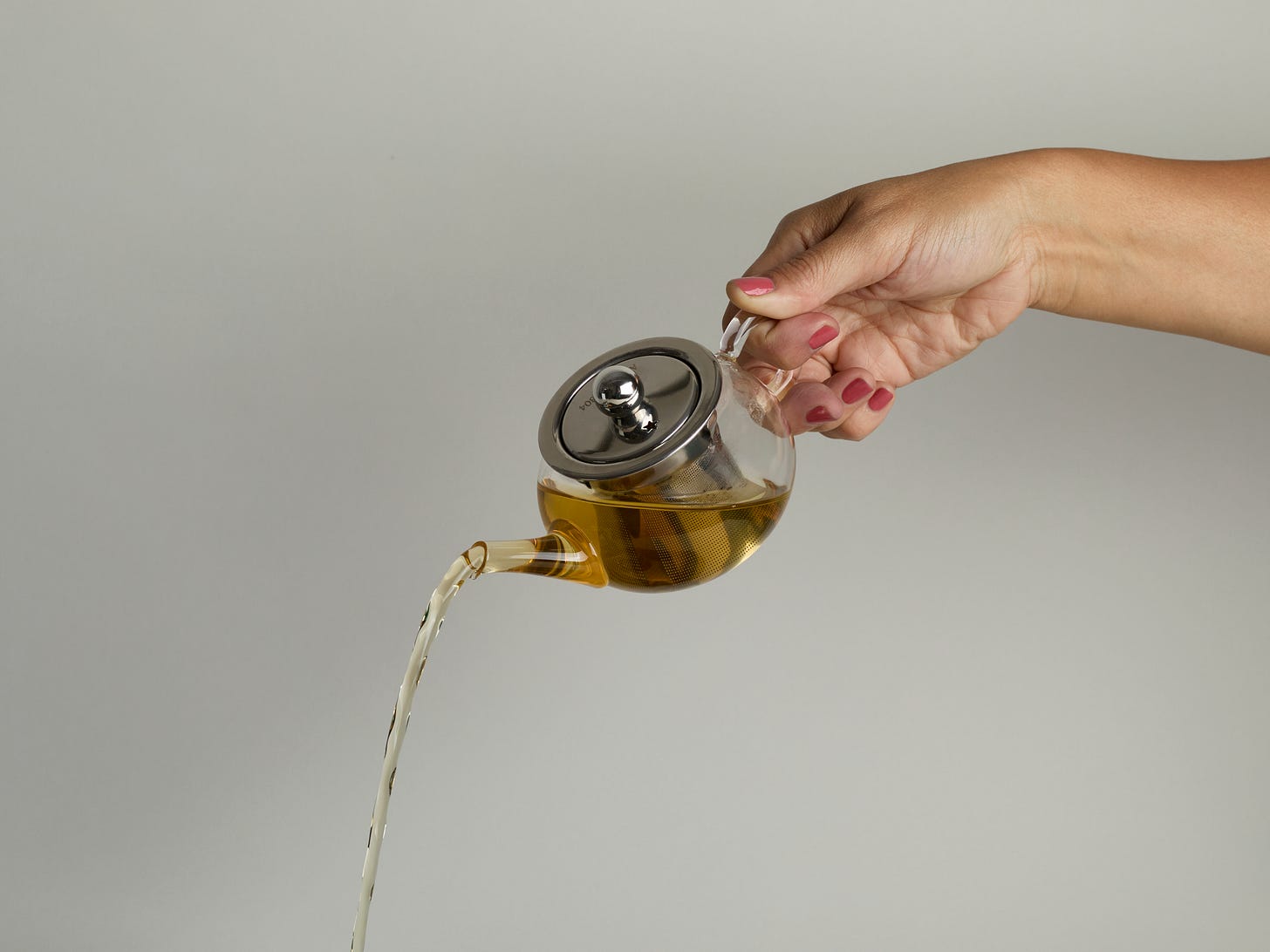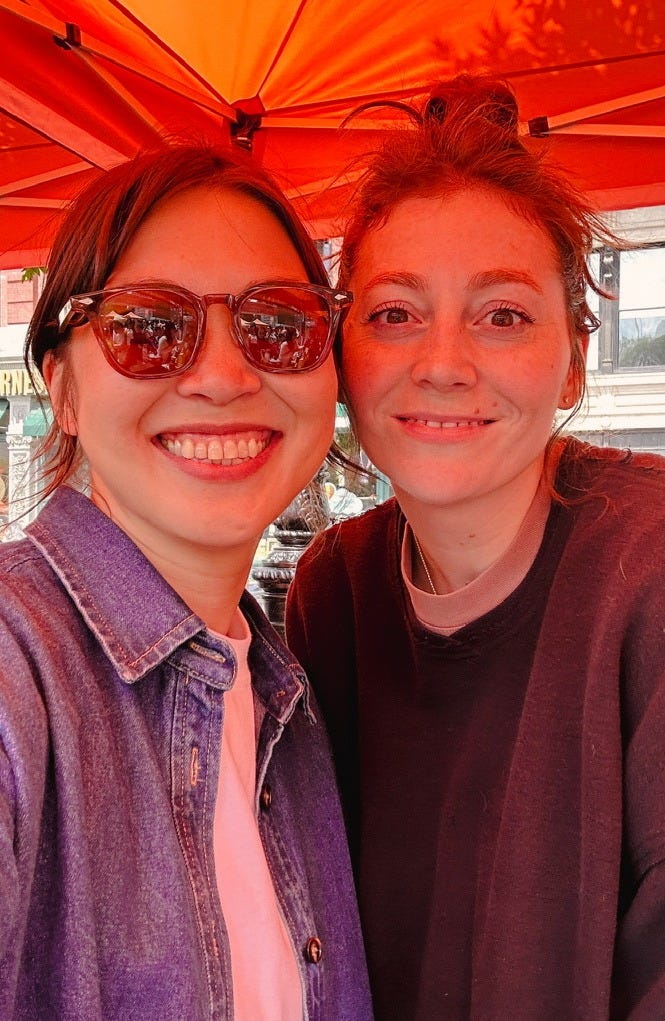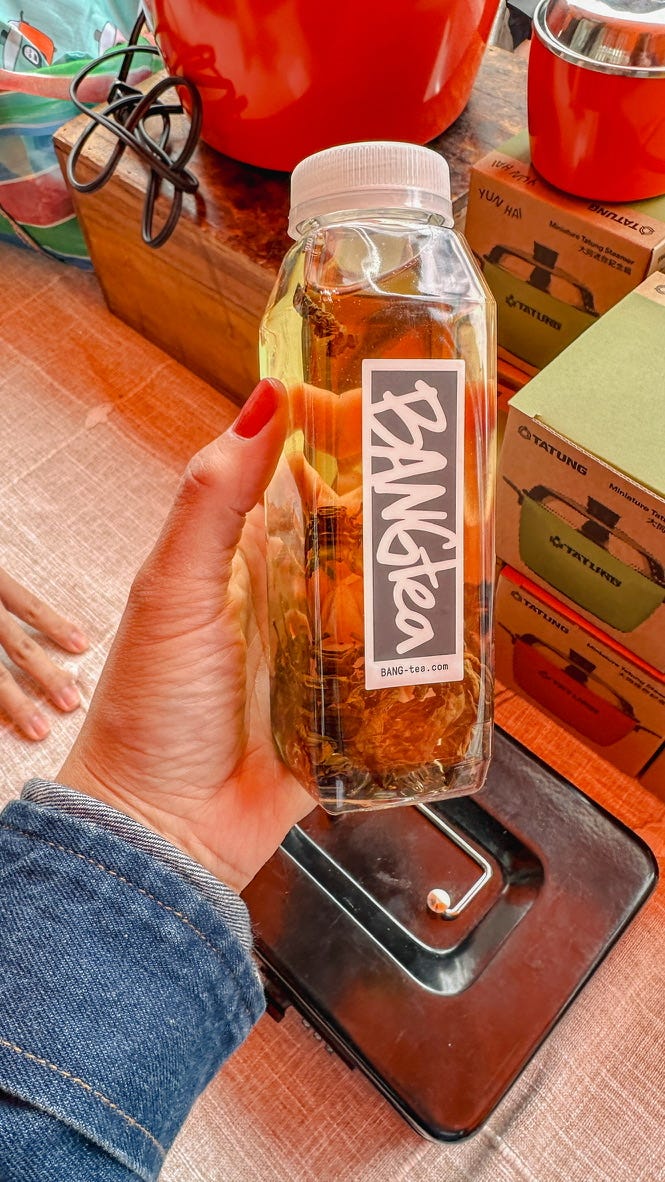青心: Shennong Style
our Taiwanese oolong tea launch
This is Yun Hai Taiwan Stories, a newsletter about Taiwanese food and culture by Lisa Cheng Smith 鄭衍莉, founder of Yun Hai. If you aren’t yet a subscriber, sign up here.
This week I have the joy of launching the Yun Hai Taiwanese Tea Collection, our newest addition to the house brand. With this introduction, we hope to bring awareness to all kinds of Taiwanese teas and their masters.
Our first lineup includes three Taiwanese oolongs from our friend Sam Tilney at BANGtea. I’ve been selling her tea in the shop since the beginning, and drinking it (daily) for even longer. I appreciate her meticulous approach to sourcing, brewing, and tasting, and her dedication to representing Taiwanese tea culture, specifically. Scroll down for more about Sam, a description of all the teas, plus our notes on how you might go about tasting and brewing them.
Finally, Mid-Autumn Festival is around the corner: October 6th. We aren’t shipping out mooncakes this year, but we’re excited to host Little Moon Bakehouse for a mooncake pop-up on September 27th. And, finally, expect details on our annual Mid-Autumn party soon.
One day, long ago, presumably on Earth, an unassuming wind blew a few leaves into a vessel of hot water. It belonged to Shennong 神農, the Divine Farmer, who took a sip, and became the first to experience the sublime beverage that is tea.
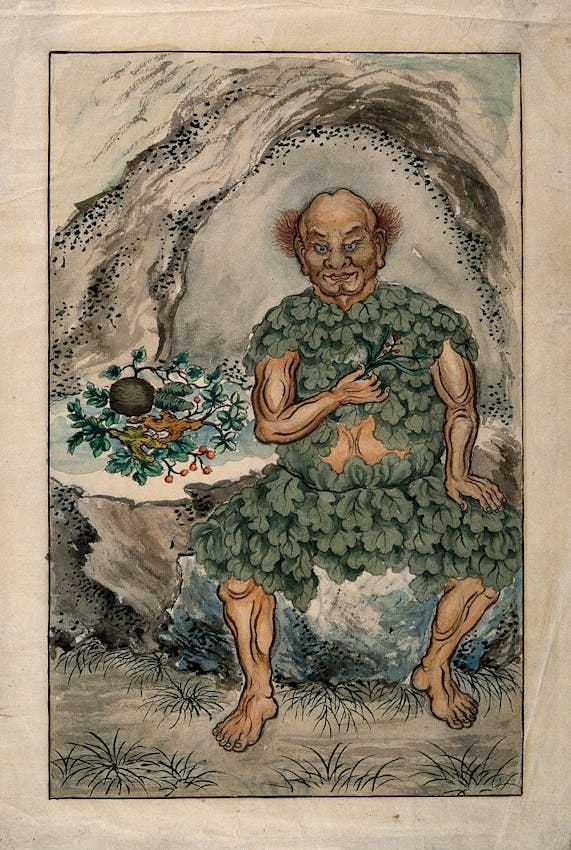
This story of a chance meeting between leaf and liquid emphasizes not just the ordinariness of the ingredients (leaf, water), but also the role of our own perception and appreciation. Would tea be tea if we were not there to taste it?
I’m being overly figurative, but I do think the magic of tea lies in its ability to bring awareness to our own senses. Not just to wake them up, but to remind us of their power and sensitivity. The rainbow of color, aroma that transcends language, the juiciness and chalkiness of the palate. How granular our perception. How rich our ability. So much in a leaf.
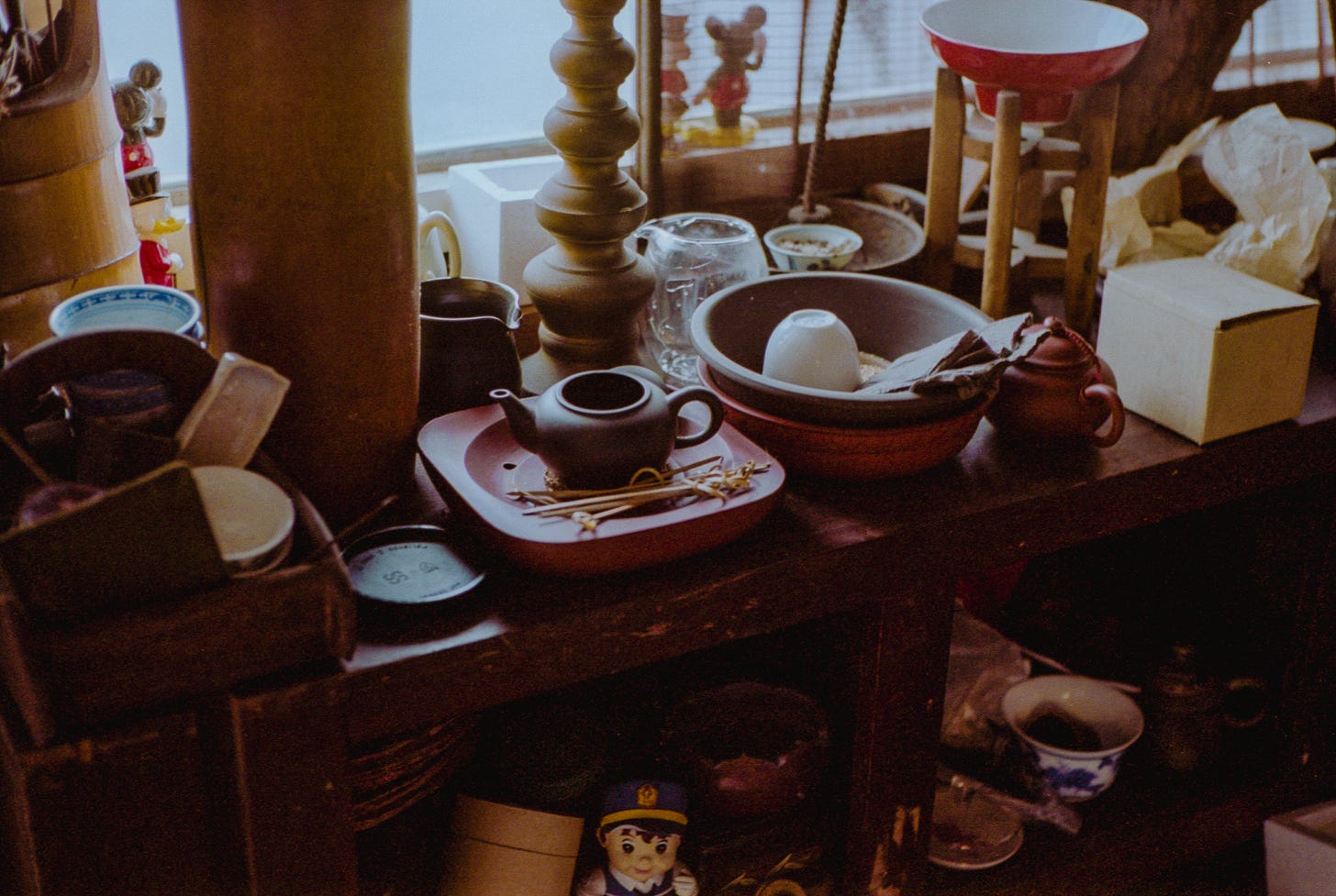
I also appreciate what the Shennong myth implies about tea appreciation: it requires almost nothing at all, by way of equipment Just water, heat, leaves, self. Maybe an errant wind.
In the world of tea, there is a wide variety of brewing techniques and rituals that create unique aesthetic experiences, but nothing special is required to enjoy the drink itself. I’m drinking mine out of a glass beaker, right now, with leaves and hot water and all. Simplicity is sometimes easy to forget when we have so many available options.
If the tea is high quality, the brewing method can be as simple or complex as suits the individual. The work of developing and transforming the flavor has been done up front, by the plant, the earth, its ecology, and the meticulous attention of the tea master.
The Yun Hai Taiwanese Tea Collection
Today, we’re launching an in-house tea collection to represent our ongoing collaborations with Taiwanese tea masters and purveyors. The idea for Yun Hai was originally ignited by experiences drinking tea in the mountains of Central Taiwan, so it’s really about time.
It was there that I first experienced “yun hai 雲海,” or sea of clouds—a phenomenon that happens in the high mountains. In the afternoon, the clouds settle lower than the mountain peaks and cover the land in a blanket of mist. When viewed from the summits, the mountaintops appear as islands in a rolling sea of vapor.
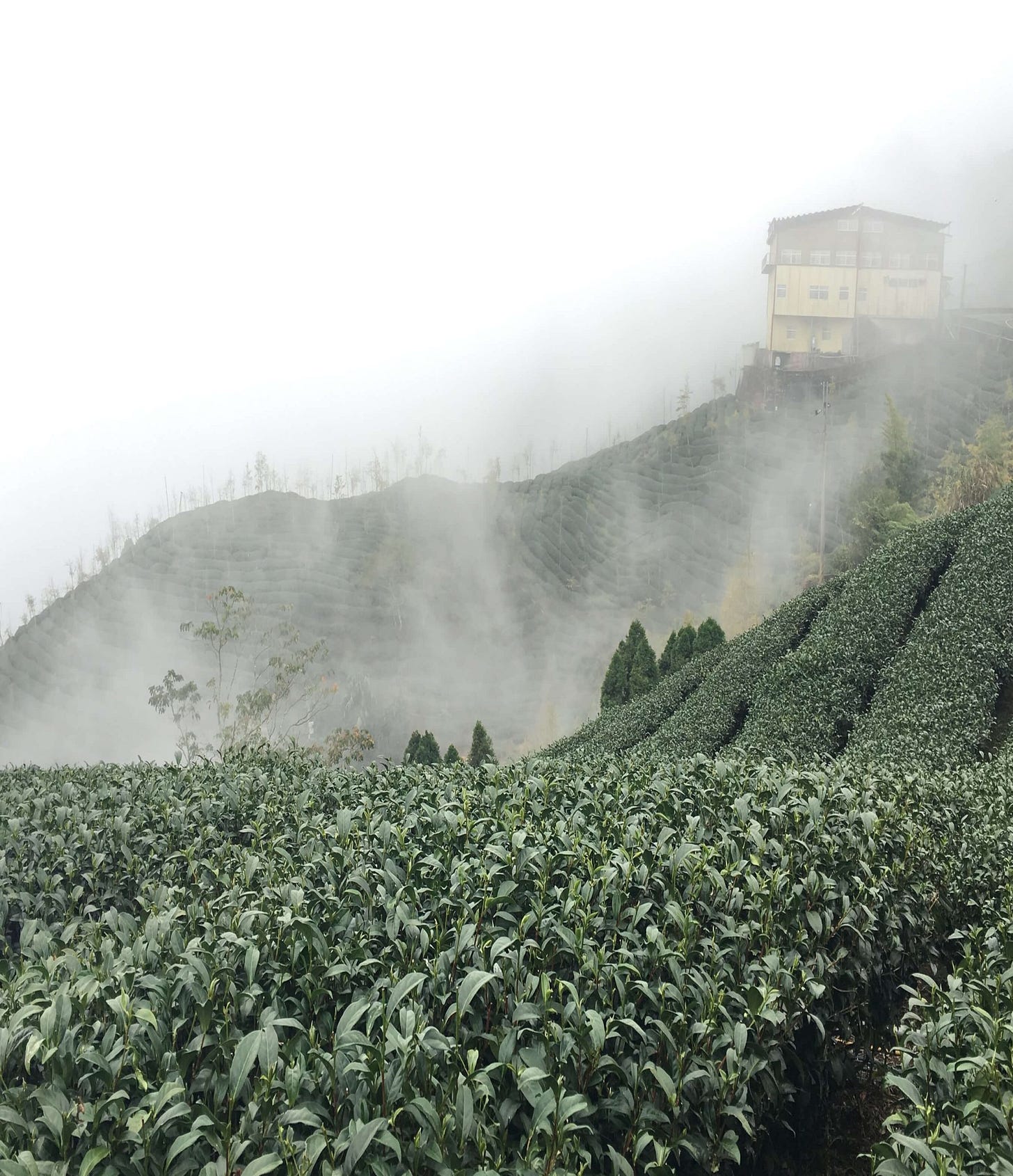
This atmospheric effect is important for growers of high mountain tea. It slows down growth, which gives the tea more time to develop flavor. For me, it also symbolizes something more—how Taiwan’s populations have come together with the terrain to produce the unique culture and cuisine we love so well. Centuries of skill and craftsmanship are stewarded by Taiwan’s tea masters, and the taste of Taiwanese tea continues to define the cuisine.
BANGtea Taiwanese Oolongs
Our first tea collection represents a selection of three Taiwanese oolongs brought to us by our close friend Sam Tilney, of BANGtea, in collaboration with the Liu family, who have a years-long relationship.
Sam, who first discovered Taiwan through her pursuit of the Mandarin language as a teenager, studied in Taiwan and fell in love with tea culture there. She established BANGtea in 2018 and visits the farmers she works with at least once a year, during harvest.
From Sam, on how she got her start:
My high school Mandarin teacher is Taiwanese and one of my mentors. She brought me to Taiwan (it was love at first sight) and encouraged me to move to Taiwan after graduation and continue studying. I drank so much bubble tea, studied abroad a second time in Taiwan, found myself buying more and more tea from farmers who became friends over the years, and eventually decided to start BANGtea to bring my favorite teas to everyone back home in the U.S.
I’m genuinely obsessed with Taiwanese oolongs. They are the best teas. I drink them from when I wake up to when I go to bed. It’s really not an exaggeration.
Sam is too humble to say this, but her taste is also impeccable.
We’re offering a green oolong (light oxidation, light roast), milk oolong (medium oxidation, medium roast), and a black oolong (heavy oxidation, medium roast). They span a spectrum of colors, flavors, and mouthfeels (keep scrolling). All are produced at the Liu Family Farm on Alishan Mountain, at 1300 meters and above. You won’t find these particular teas sold by anyone else; they’re sought after and never make it to general distribution.
We chose to kick off our tea collection with BANGtea not just because we love the teas, but because her philosophy and love for Taiwan mirrors our goals for the collection. These teas have been handpicked (literally and figuratively) for you. For each tea brought into the collection, BANGtea has sampled at least 80-100 different teas, from thousands. Like all Yun Hai products, we intend to bring you the best.
About the Oolongs
The teas are all hand-picked—just the bud and first three leaves—and ball-rolled, which drastically reduces the transportation volume. When brewed, these tiny pellets of green unfurl to reveal intact stems and leaves, which is the farmer’s way of showing the drinker that they were truly manually harvested.
Sam usually sells teas by the season, which is exciting for the connoisseur—you get to taste how each harvest differs. We're taking a different approach, focusing on consistency and accessibility. Rather than seasonal releases, we've selected specific teas to be year-round offerings, packaged in compact boxes with brewing instructions from BANG. We hope they'll become your go-to daily drinkers, too.
Green Oolong
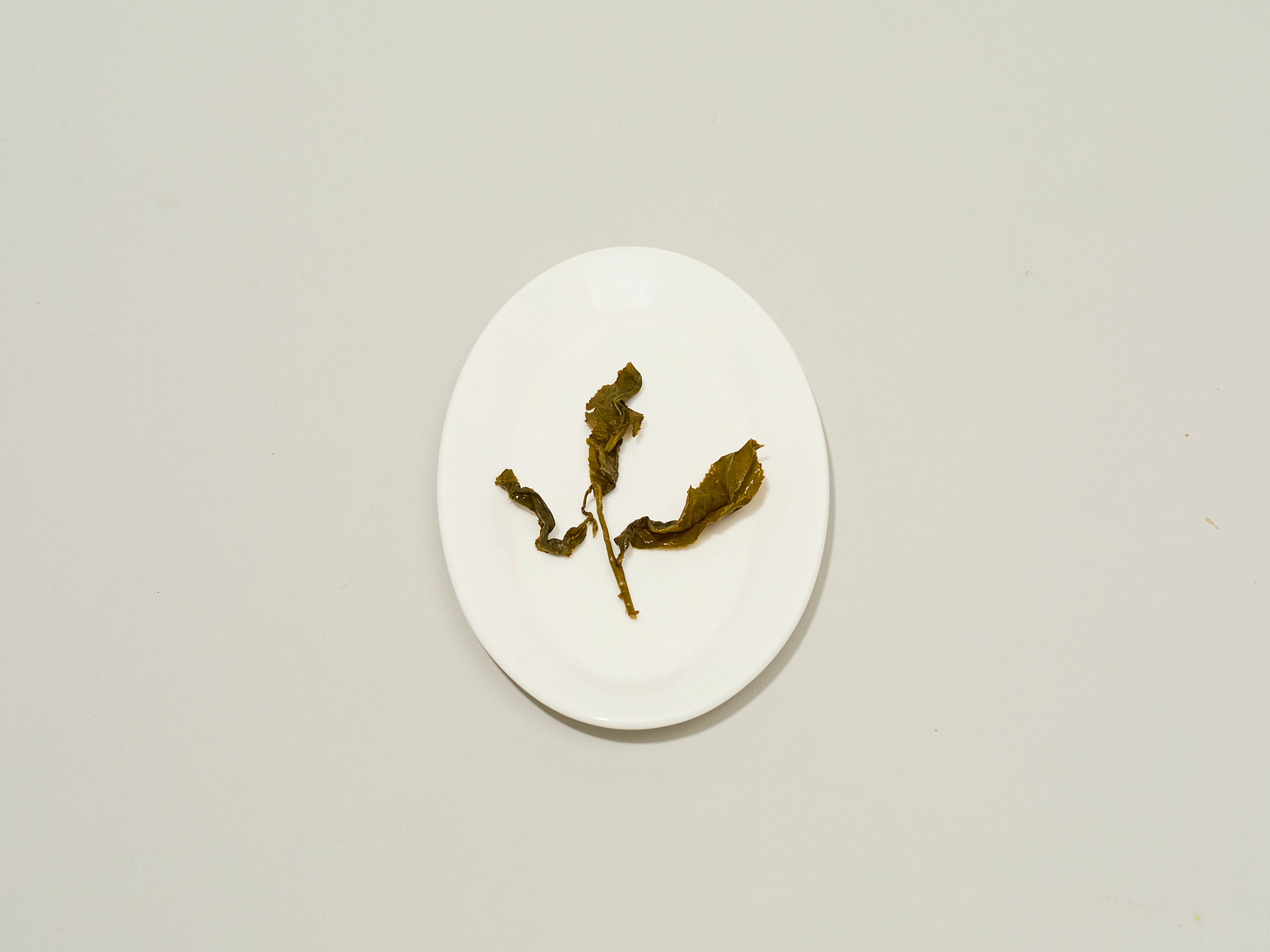
This green oolong has a juicy character that leaves a tingly, dry sensation on the palate. Brewing produces a pale yellow broth with the aromas of gardenia and fern, and delicate tasting notes of white asparagus and macadamia nut.
Made from the qingxin 青心 cultivar, it’s produced with light oxidation (10%) and a light roast. It’s verdant and grassy.
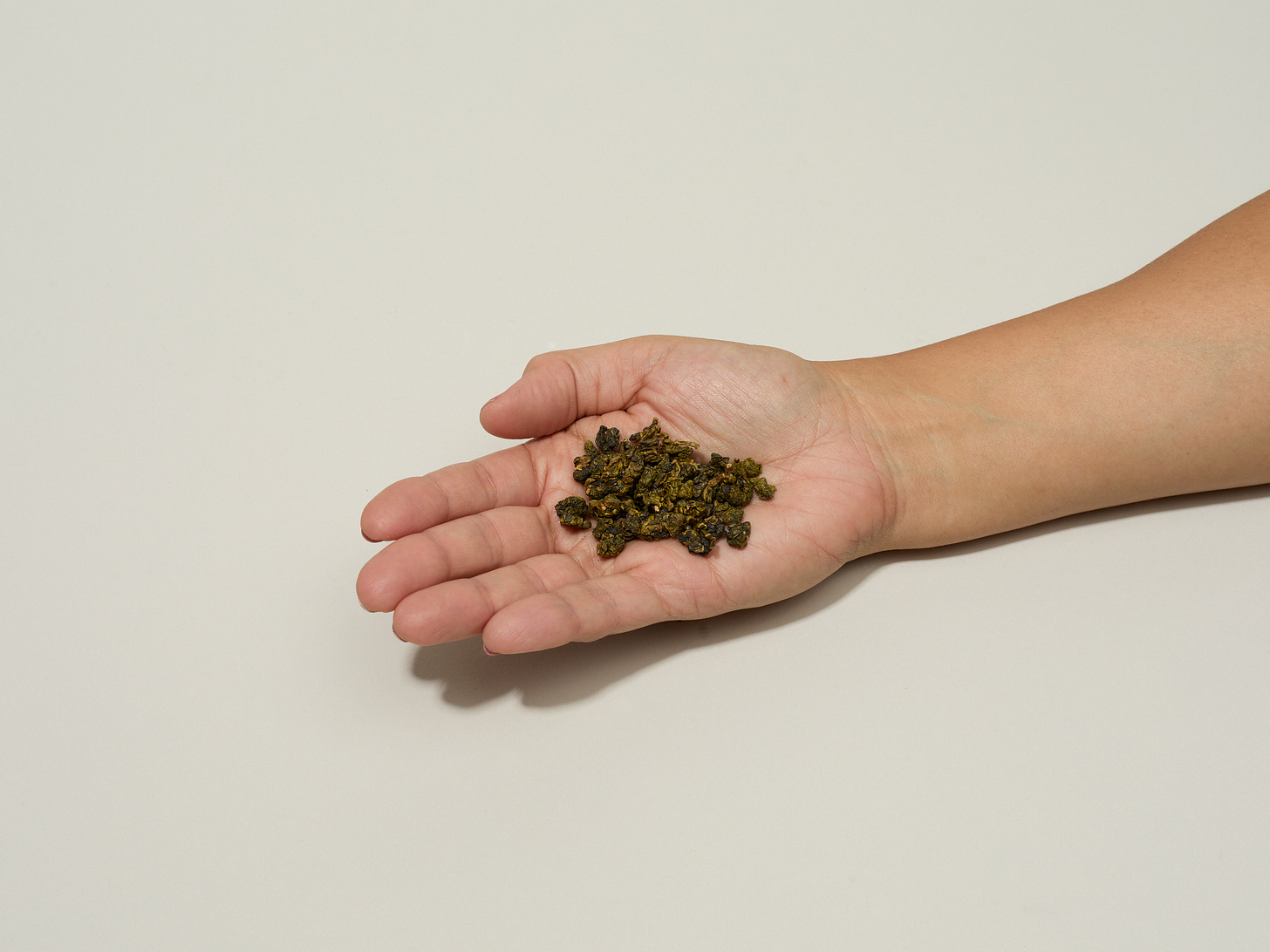
Origin: Alishan Township, Chiayi County, Taiwan
Elevation: 1300 meters
Cultivar: Qingxin 青心
Oxidation: 10%
Roast: Very light
Tasting Notes: gardenia, fern, macadamia nut
Brewing: 5g per 150ml water / 205 degrees / 45 sec / multiple brews
Milk Oolong
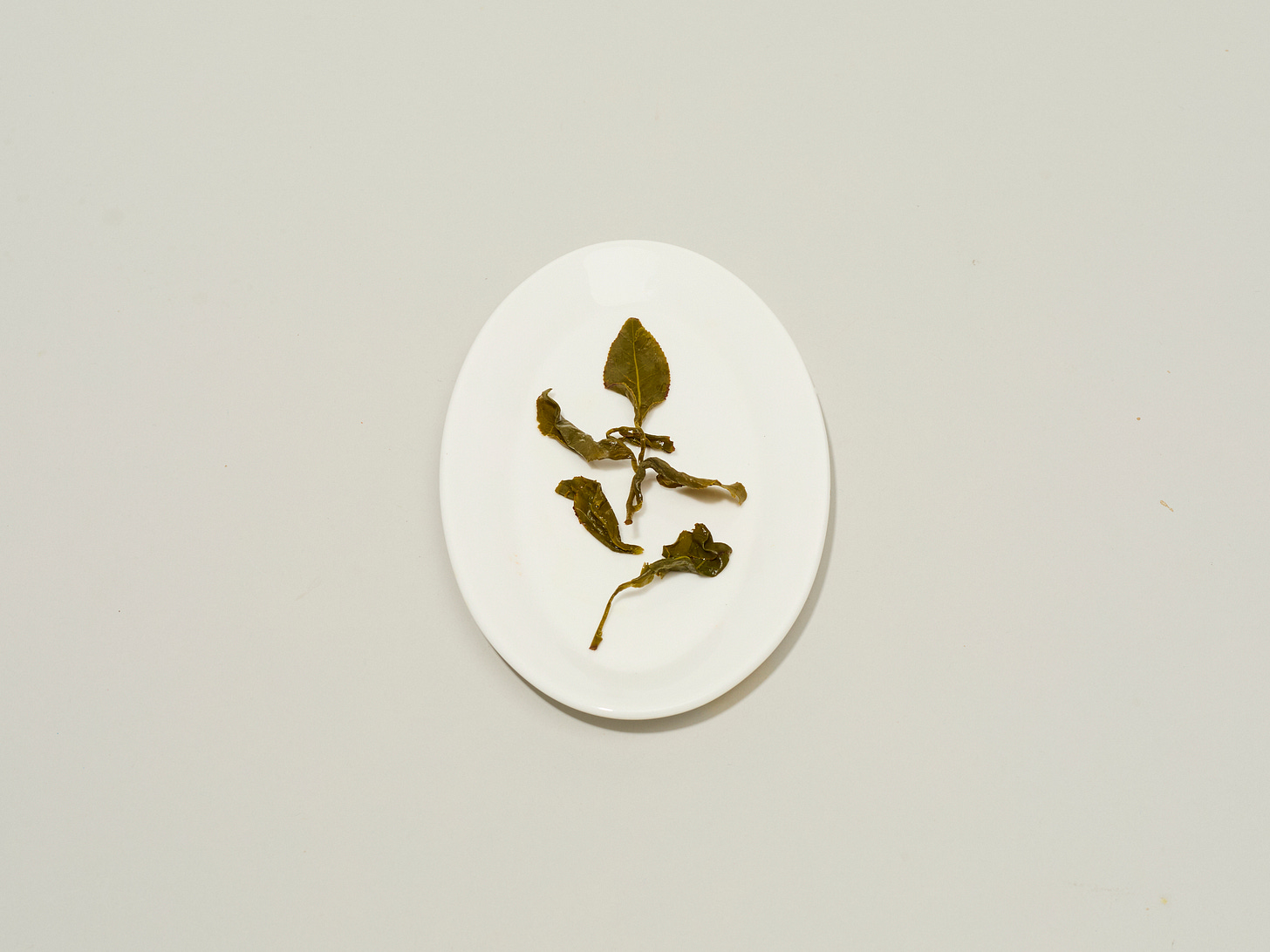
This milk oolong has a velvety character and buttery shortbread aroma. Brewing produces a flaxen-colored broth with subtle tasting notes of sweet cream, pear, and wildflowers.
Made from the jinxuan 金萱 cultivar, it’s produced with light oxidation (25%) and a 15 hour roast, leading to a plushly textured tea with a surprisingly delicate flavor.
Origin: Alishan Township, Chiayi County, Taiwan
Elevation: 1300 meters
Cultivar: Jinxuan 金萱 "milk oolong"
Oxidation: 25%
Roast: Slowly roasted for 15 hours
Tasting Notes: sweet cream, pear, wildflowers
Brewing: 5g per 150ml water / 205 degrees / 60 sec / multiple brews
Black Oolong
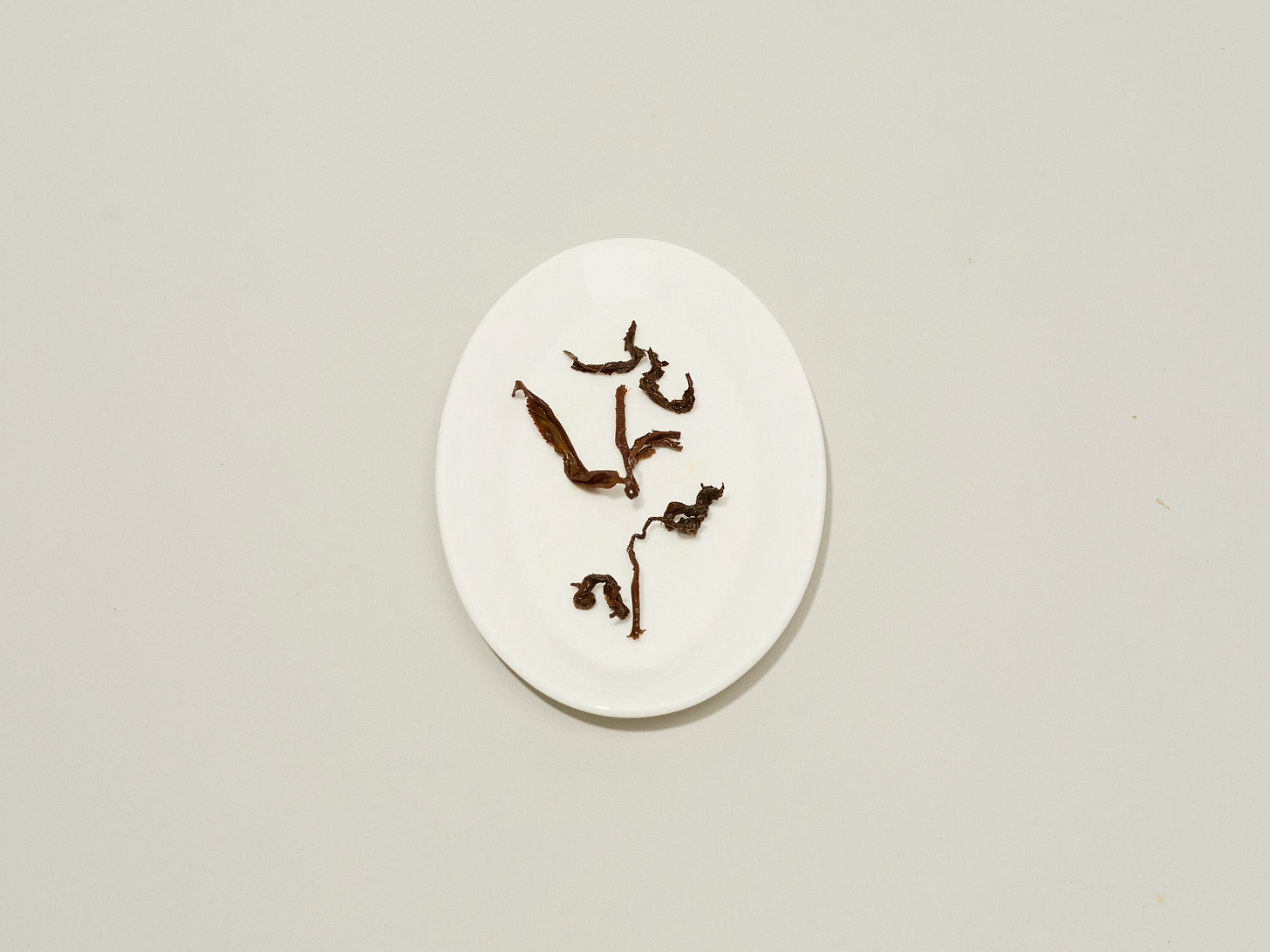
This black oolong has a smooth, creamy character and a fragrance that carries caramel and fresh soymilk aromas. Brewing produces an amber broth with notes of honey and plum.
Made from the jinxuan 金萱 cultivar, it’s produced with heavy oxidation (90+%) and a 15 hour roast, which produces a richness reminiscent of black tea.
Origin: Alishan Township, Chiayi County, Taiwan
Elevation: 1300 meters
Cultivar: Jinxuan 金萱 "milk oolong"
Oxidation: 90+%
Roast: Slowly roasted for 15 hours
Tasting Notes: cacao, honey, plum
Brewing: 5g per 150ml water / 210 degrees / 50 sec / multiple brews
Shennong Style
When I first started drinking tea with Sam, we’d sometimes brew gongfu cha style with a gaiwan. If you’re unfamiliar, it’s a lidded tea bowl that permits brewing small amounts of tea very quickly.
But, more often than not, we’d brew in Sam’s signature style, with nothing more than a glass beaker. Sam describes this approach as “grandpa style”—throw some leaves and water into a vessel and don’t worry about it—I immediately thought of Shennong and his unassuming primordial brew. I guess Shennong is the ultimate grandpa, after all.
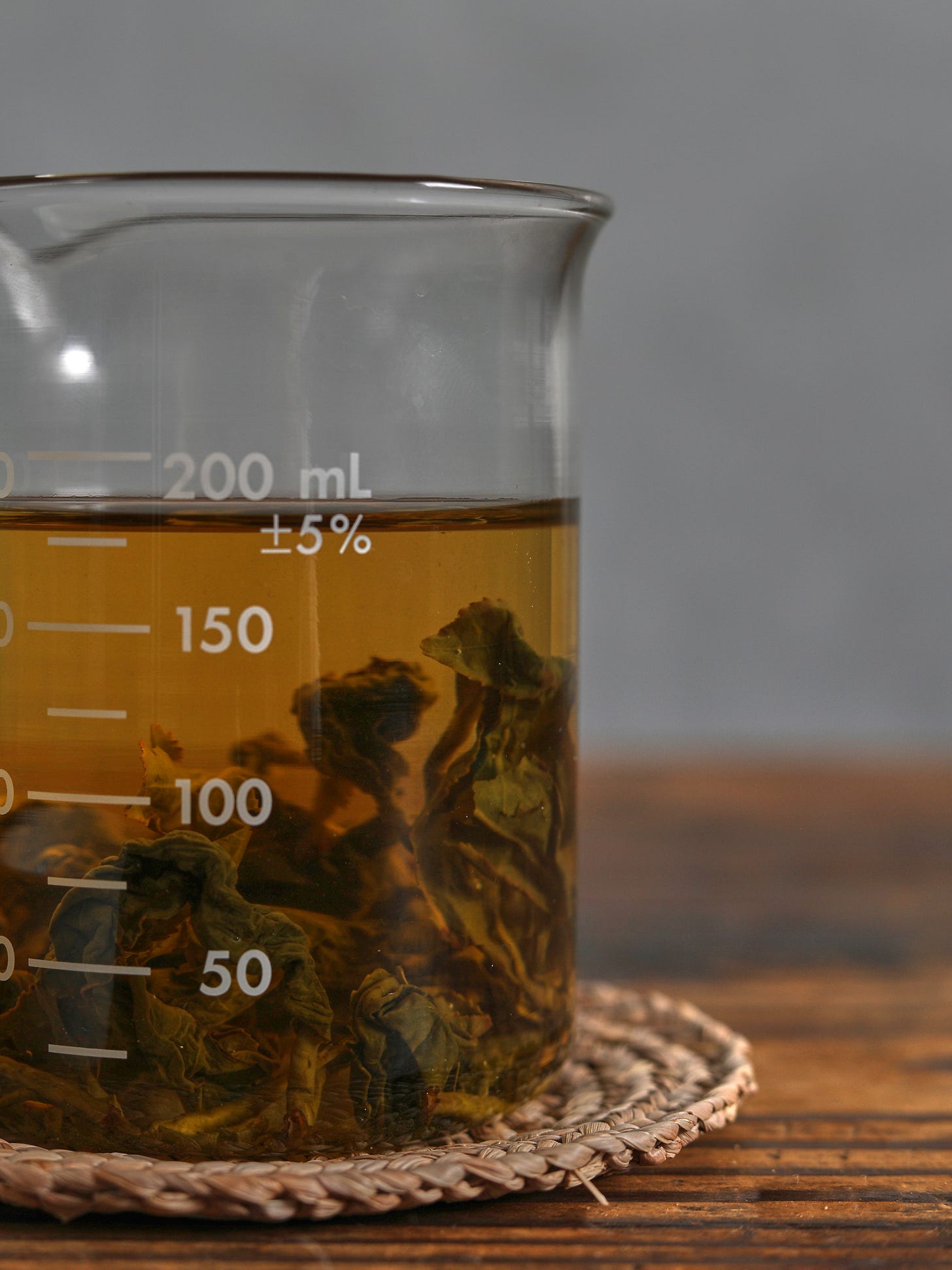
I’ve probably never said this to Sam, but this casual approach exudes confidence about the tea, and puts people at ease to drink it on their own terms.
For a cold Shennong (we’re just calling that now), make a cold brew. Add 8-10g of tea into a 16oz water bottle, and let it steep in the fridge overnight.
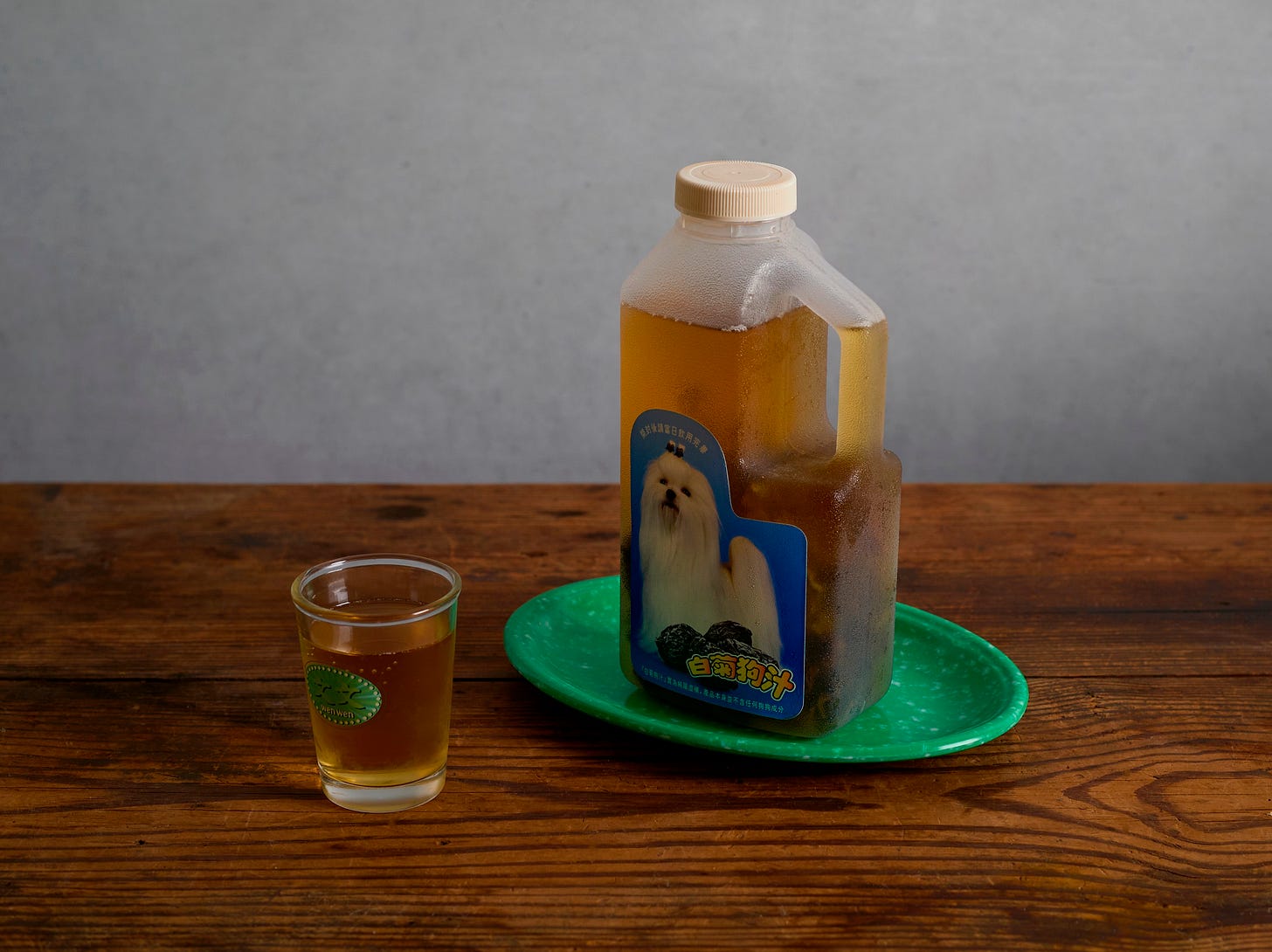
Tasting Suggestions
While I am brewing-method agnostic and feel that great results can be achieved in many ways, I do feel strongly about using your senses to experience the tea in all of its stages. I’ve picked up a few tips on how to taste, many of these from Sam.
Try:
Rolling the leaves around in your hand to appreciate the color, shape, weight, and density.
Smelling the leaves before and after brewing—dry and wet—for a completely different experience. Sam recommends putting your nose into the brewing vessel, breathing out hot air, and then inhaling. The heat from your body warms up the leaves and activates their flavor and scent compounds.
Tasting the broth by rolling it around in your mouth before swallowing. Notice the parts of your mouth being activated. Is it juicy along the sides of the tongue? Chalky on the palate? Lingeringly sweet in the back of the throat?
Naming Conventions
Before this launch, Sam and I had a brief chat about oolong tea naming conventions, and I’m sharing what I’ve learned here.
If you’re familiar with Taiwanese oolongs, you may have heard of Baozhong Tea 包種茶, Dong Ding Oolong 凍頂烏龍, Tieguanyin 鐵觀音, or Dongfang Meiren 東方美人. These names can be helpful, and are full of meaning, but for those new to tea, they may also be mystifying.
Certain names, like Tieguanyin, describe both the production process and the cultivar. Others, like Milk Oolong, may describe the cultivar only, with production processes varying. Some may reference a region, like Dong Ding Oolong, which refers to tea that comes from Dong Ding mountain.
BANGtea uses their own conventions, which we’ve followed in our collection, to focus on the flavor profile and relative boldness of the tea. Green for a light oxidation, milk for the jinxuan cultivar, and black for a more heavily oxidized oolong that approaches a black tea in richness. Each tea has cultivation and production stats describing origin, cultivar, oxidation, and roast, all of which have a big impact on flavor.
We recommend that you read the production details on the box or our website as you drink the tea and make note of what you like. This can help orient you as you continue to try more teas, or give you a sense about how this tea might compare to ones you already love.
A-OK Teapot
Icing on the cake: we’re also launching my favorite little teapot, found on a recent trip to Taiwan. It’s a plump, no-frills, glass and stainless steel number from a Taiwanese hardware store supplier and embodies the casual, low-to-the-ground approach we take to our tea: it’s sturdy, practical, and well-engineered, but also beautiful with a soft affect, round handle, star-shaped ventilation hole, and “A-OK” emblazoned on the lid.
It’s 200ml, sized similarly to a mug. I make an entire pot and pour it all out into another vessel (mug or beaker) in one go, which mixes the flavors together into an even brew.
An important note: though the teapot is sold by a Taiwanese hardware store supplier, it is produced in China. Before sourcing it, we searched far and wide for borosilicate glass teapots produced in Taiwan, including well-known Taiwan brands like Eilong and Taiwan Glass, but manufacturers have moved their operations elsewhere.
While we exist to promote as many made-in-Taiwan products as possible, we also recognize that a number of beloved Taiwanese brands produce across multiple countries, including China. This is a reality of the Taiwanese economy.
This is similar to the stainless steel bowl clip we source for the Tatung—we couldn’t find one made in Taiwan, but source it from a Taiwanese company who produces in China.
Because our ultimate goal is to bring attention to the stories behind Taiwanese foodways, we choose to include these products for their heritage and importance to Taiwanese cuisine, when relevant. We remain committed to always sourcing Taiwan-first, when possible.
To conclude, I just want to bring some love back to Sam.
She’s been showing up for Yun Hai and Taiwan since the early days, as a supporter, fan, ambassador, nd collaborator. She volunteers for us every year at Passport to Taiwan, New York City’s biggest Taiwanese street festival, where she exercises her impressive Mandarin to pitch our Taiwanese fruit and help explain our BOGO deals to the very discerning Taiwanese aunties. Thank you, Sam!
And sneak preview—we’re working on BANGtea cold brew for the shop. Stay tuned!
a plump, no-frills, glass and stainless steel number from a Taiwanese hardware store,
Lisa Cheng Smith 鄭衍莉
Written with editorial support by Amalissa Uytingco, Jasmine Huang, and Lillian Lin. If you enjoyed this newsletter, please share it with friends and subscribe if you haven’t already. I email once a month, sometimes more, sometimes less. For more Taiwanese food, head to yunhai.shop, follow us on instagram and twitter, or view the newsletter archives.






